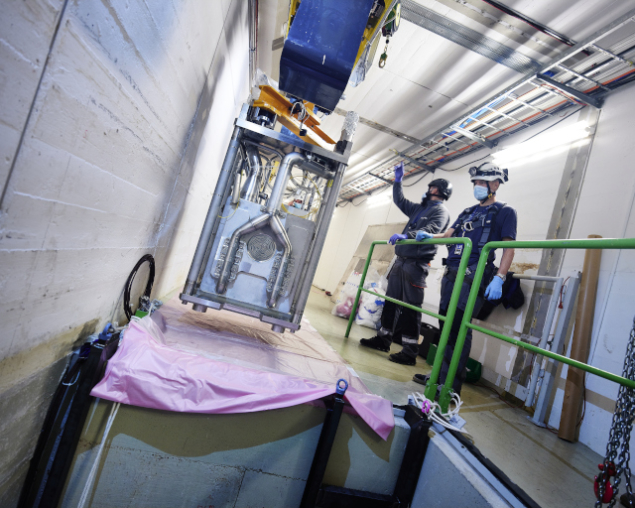
The Neutron Time Of Flight (n_TOF) facility at CERN, a project proposed by former Director General Carlo Rubbia in the late 1990s, started operations in 2001. Its many achievements during the past two decades, and future plans in neutron science worldwide, were the subject of a one-day hybrid event NSTAPP – Neutrons in Science, Technology and Applications organised by the n_TOF collaboration at CERN on 22 November.
At n_TOF, a 20 GeV/c proton beam from the Proton Synchrotron (PS) strikes an actively cooled pure-lead neutron spallation target. The generated neutrons are water-moderated to produce a spectrum that covers 11 orders of magnitude in energy from GeV down to meV. At the beginning, n_TOF was equipped with a single experimental station, located 185 m downstream from the spallation target. In 2014, a major upgrade saw the construction and operation of a new experimental test area located 20 m above the production target to allow measurements of very low-mass samples. Last year, during Long Shutdown 2, a new third-generation, nitrogen-cooled spallation target was installed and successfully commissioned to prolong the experiment’s lifetime by ten years. At the same time, a new close-to-target irradiation and experimental station called NEAR was added to perform activation measurements relevant nuclear astrophysics and measurements in collaboration with the R2E (Radiation to Electronics) project that are difficult at other facilities.
Advancing technology
During 20 years of activities, the n_TOF collaboration has carried out more than 100 experiments with considerable impact on nuclear astrophysics, advanced nuclear technologies and applied nuclear sciences, including novel medical applications. Understanding the origin of the chemical elements through the slow-neutron-capture process has been a particular highlight. The high instantaneous neutron flux, which is only available at n_TOF thanks to the short proton pulse delivered by the PS, provided key reaction rates relevant to big-bang nucleosynthesis and stellar evolution (the former attempting to explain the discrepancy between the predicted and existing amount of lithium by investigating 7Be creation and destruction, and the latter determining the chemical history of our galaxy).
Basic nuclear data are also essential for the development of nuclear-energy technology. It was this consideration that motivated Rubbia to propose a spallation neutron source at CERN in the first place, prompting a series of accurate neutron cross-section measurements on minor actinides and fission products. Neutron reaction processes on thorium, neptunium, americium, curium, in addition to minor isotopes of uranium and plutonium, have been all measured at n_TOF. These measurements provide the nuclear data necessary for the development of advanced nuclear systems, such as the increase of safety margins in existing nuclear plants as well as to enable generation-IV reactors and accelerator-driven systems, or even enabling new fuel cycles which reduce the amount of long-lived nuclear species.
Basic nuclear data are also essential for the development of nuclear-energy technology
Contributions from external laboratories, such as J-PARC (Japan), the Chinese Spallation Neutron Source (China), SARAF (Israel), GELINA (Belgium), GANIL (France) and Los Alamos (US), highlighted synergies in the measurement of neutron-induced capture, fission and light-charged-particle reactions for nuclear astrophysics, advanced nuclear technologies, and medical applications. Moreover, technologies developed at CERN have also influenced the creation of two startups, Transmutex and Newcleo. The former focuses on accelerator-driven systems for energy production, for which the first physics validation was executed at the FEAT and TARC experiments at the CERN PS in 1999, while the latter plans to develop critical reactors based on liquid lead.
With the recent technical upgrades and the exciting physics programme in different fields, such as experiments focusing on the breaking of isospin symmetry in neutron-neutron scattering and pursuing its core experimental activities, the n_TOF facility has a bright future ahead.





